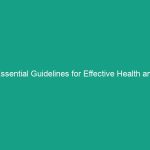Introduction
Good morning team,
Today, we’re going to discuss a topic that is crucial for our Workplace Safety: Essential Workplace Law Guidelines: Avoid These Critical Risks Today. Understanding workplace laws and Regulations is not just about compliance; it’s about creating a safe and productive Environment for all of us.
Why is this important? Because adhering to these guidelines can prevent workplace injuries, legal issues, and foster a culture of Safety that Benefits everyone. Let’s dive into the details!
Understanding Essential Workplace Law Guidelines
Essential Workplace Law Guidelines refer to the rules and regulations that govern the Safety and health Standards in our workplace. These laws are designed to protect employees and employers from potential risks and liabilities.
Understanding these guidelines is vital for several reasons:
- Protection: They safeguard employees from hazardous work conditions.
- Compliance: They ensure that the company adheres to legal requirements, reducing the risk of fines and lawsuits.
- Culture: They promote a culture of safety, encouraging employees to prioritize their health and well-being.
Many employees mistakenly believe that workplace laws are only a concern for management. However, everyone has a role to play in maintaining compliance and safety.
Key Hazards, Risks, and Safety Considerations
Now, let’s explore some of the specific Hazards and risks associated with workplace law guidelines:
- Workplace Injuries: Failing to adhere to safety protocols can lead to serious injuries, such as slips, trips, falls, and exposure to harmful substances.
- Legal Consequences: Non-compliance with workplace laws can result in legal actions, fines, and even shutdowns.
- Employee Morale: Ignoring safety regulations can lead to a decline in employee morale and productivity.
Ignoring these safety considerations can have real-world consequences, including injuries, loss of trust, and significant financial and legal repercussions for the company.
Best Practices, Procedures, & Actionable Advice
To minimize risks and ensure compliance with workplace law guidelines, here are some Best Practices we must follow:
1. Regular Training and Refreshers
Ensure that all employees receive regular training on safety protocols, workplace laws, and emergency Procedures. Consider conducting refresher courses every six months to keep everyone updated.
2. Clear Communication of Policies
All workplace law guidelines should be clearly communicated to employees. Make sure that everyone understands the policies and procedures in place to protect their safety.
3. Reporting Mechanisms
Establish an open and anonymous reporting system for employees to report safety concerns or violations without fear of retaliation. This encourages a culture of safety and transparency.
4. Conduct Regular Safety Audits
Regular audits can help identify potential hazards and areas of non-compliance. Make it a priority to address any issues that arise during these audits.
5. Use of Personal Protective Equipment (PPE)
Ensure that all employees have access to and use appropriate PPE for their specific tasks. This includes helmets, gloves, goggles, and respiratory protection where necessary.
Real-World Incident: Case Study
Let’s consider a real-world incident where a manufacturing facility faced legal action due to non-compliance with safety regulations. An employee suffered severe injuries from a machine that was not properly guarded. The facility faced hefty fines and lawsuits, not to mention the impact on employee morale. This incident underscores the importance of following safety protocols and regularly reviewing workplace law guidelines.
Regulations, Standards, and Compliance
It’s essential to be aware of the regulations that govern Workplace Safety. Some relevant standards include:
- OSHA Standards: The Occupational Safety and Health Administration sets regulations to ensure Workplace Safety.
- ISO Standards: The International Organization for Standardization provides guidelines for safety management systems.
- Company-Specific Policies: Familiarize yourself with our company’s specific safety policies and procedures.
Compliance with these regulations is critical. It not only protects employees but also shields the company from legal liabilities and enhances its reputation.
Employee Engagement & Discussion
Now, I want to hear from you! What safety challenges have you encountered related to workplace law guidelines? How do you think we can improve our safety practices? Your insights are valuable, and sharing experiences can help us learn from each other.
Conclusion & Key Takeaways
In summary, understanding and adhering to Essential Workplace Law Guidelines is vital for our safety and well-being. By following Best Practices, communicating effectively, and remaining compliant with regulations, we can minimize risks in our workplace.
Remember, safety is a shared responsibility, and everyone plays a crucial role. Let’s commit to prioritizing safety in everything we do!
Thank you all for your attention and for your ongoing commitment to a safe work environment.


